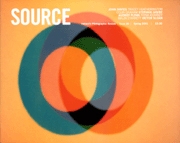Re-enter Ophelia
'Extreme Unction - From the Ophelia Room' by Abigail O'Brien was at Galerie Bugdahn und Kaimer, Düsseldorf, 27th October - 23rd December 2000
Review by Stefanie Grebe
Issue 26 Spring 2001
View Contents ▸
Extreme Unction - From the Ophelia Room by Abigail O'Brien is the fifth installation in her series Sacraments. The series relates to the Catholic convention of the Seven Sacraments, with the Fifth Sacrament being the Extreme Unction. The exhibition combines a small photograph and ten large-format photo works with five glass cases containing small flower embroideries stitched by the artist, a sound-piece and a thawing urn moulded from ice.
The photographs show found and subtly arranged scenes from the old and new post offices in Dublin, a letter-sorting machine (diptych), Dead Letter Rooms (as triptych and single image), mail-bags and the view onto three locked doors in a morgue (five photos as a series). Promise #1, 2000
Promise #1, 2000
The rooms of the post office and the morgue are mostly shown frontally and symmetrically, in a photo-documentary style. They become a spatial foil for objects which point to a narrative sphere. Postcards, a photograph and an object are placed - seemingly the only intervention in a situation which could not be coincidental. This factual and detached manner of depiction is channelled by the presence of significant details. Several postcards of reproductions of works of art emerge as images- within-images. These narrative hints beg to be deciphered meticulously. One motif appears in the morgue as well as in the post-office. Not only are motifs (of the postcards, the photographs, the embroidery) repeated and varied, the three-part structure of the triptych is found again in a single image (Pending) and in the plates of the triptych (Promise) itself.
Abigail O'Brien's room installation is Ophelia's room, not a stage set, but the real space for an imaginary figure. The post-office is transformed into a symbolic emporium, a final resting place for travelling messages; the morgue becomes the people's last station and a pinboard where a life-story is commemorated by pictures. Both are the sites of a criminal case in need of unravelling. Connections need to be drawn between the signs and details of the images. Trails have been placed which can be followed through the exhibition. The spectator feels like a judge asked to consider the circumstantial evidence. The embroidery is given a special position within the installation as haptic pieces of evidence. The poetry of all this evidence is beguiling and at the same time a trail is laid leading into the past, into the seventeenth century. Who refuses whom a letter, which unopened letters bring disaster and which corpse is behind the door (of the morgue The Ophelia Room #1-5)?
The phenomenology of the letter is introduced and merged with the character ophelia. Whereas Hamlet was able to act because he was 'free', ophelia was placed under the authority of her father, who had prohibited any communication with Hamlet. Ophelia plunges into the symbolic language of flowers, into the unconscious, into madness and then into the water. She expresses her penultimate message with flowers. The embroideries in the exhibition are Ophelia's original expression, her literal speech. Seen within the context of cultural history, these embroideries function as a specifically female form of communication, disguised as a present. Ophelia's last message is her death. The melting ice sculpture of the urn corresponds with the water in which Ophelia finds her death. Suicide, accident, murder or manslaughter? A logical death, but not a peaceful one. A female death.
The morgue's door is the final destination for the postcards. The images recount Ophelia's story. They enter tnto a special liaison with the embroideries and the image of the bundled letters (Dead Letter Room) which remain forever unopened or constitute a closed chapter of the past. The photograph, the letter and the embroidery register the imprint of the real and can be deciphered as a trace and at the same time as a relic and an informed messenger. All may transmit lies. However, the letter and the embroidery are addressed exclusively to one recipient. Death is at the end of these attempts to communicate via letter and flower (embroidery - Memento). Four embroideries are in black-grey- white and one is in colour. Two contain quotations which refer to Ophelia's explanation of the herbs and flowers with which she had adorned herself. The parring of herbs and flowers with a particular meaning is the result of a wild logic. Daisies are displayed by the artist as a sequence of plucked petals to suggest the game 'He (Hamlet) loves me, loves me not ...'
Abigail O'Brien's way of narration is breathtakingly complex and logical. A closely-knit and multi-layered story is told here. The prose of the factual never masks the poetry of the imaginary. Each sign that she sets, be it the installation as a whole, the individual parts, or the titles of her works, are very precise, poignant, poetical and they urge us to investigate further. The viewer becomes entangled in the network of references between her images, the objects and the invisible behind it all.
The tragedy of Hamlet is read here as the story of opheria and of the undelivered, returned, and forged letters with orders which mean death. Her tragedy is completely dissolved in Extreme Unction - From the Ophelia Room but leaving a trace. Even if one does not know Hamlet one can sense the inevitability of death; the transitoriness of even the last remains and the life-long futility of communication with others.
Other articles mentioning Abigail O'Brien:
Other articles on photography from the 'Religious' category ▸






